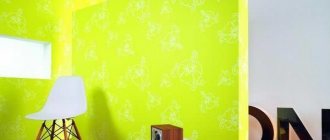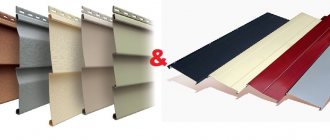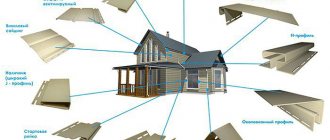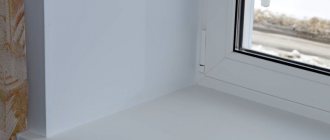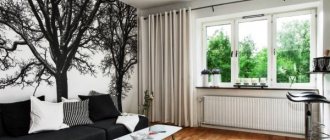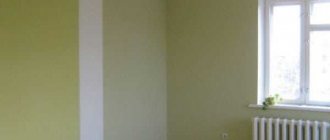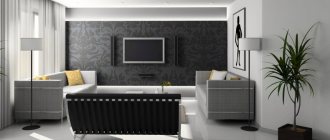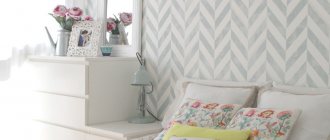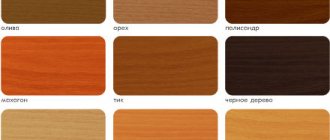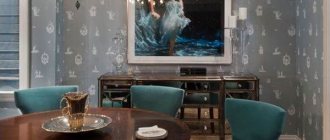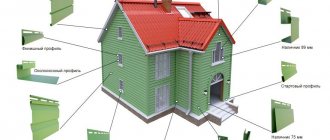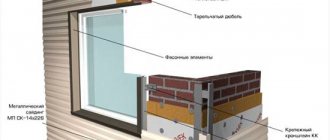The time when all residential buildings were similar to each other is long gone, and modern facades differ not only in shape, but also in a wide variety of shades. The color palette of finishing materials makes it easy to implement the most daring and unusual decisions when arranging a home, making it more vibrant and exclusive. The greatest scope for this is provided by siding - one of the best types of finishing with a wide choice of texture and color of panels.
Siding: colors
What to look for when choosing a harmonious combination of shades
PVC siding and its huge color palette sometimes causes stupor.
How to decide on such a variety of finishes? Every year there are more manufacturers, new shades and textures are added. Therefore, the question “How to choose the color of siding and roofing” remains one of the most popular. When choosing the color of siding, you should also take into account the shades of the roof, drainpipes, plinth, doors, window frames and other elements.
Fiber cement siding Cedral
There are several aspects that you must pay attention to in order to create a harmonious combination of shades:
- Management requirements from the locality (if any).
- Geographical location and climatic conditions: special attention to relief and type of terrain.
- Technical characteristics of the house, its parameters and purpose.
Already based on these criteria, you can cut off some of the color schemes of vinyl siding or panels.
Next, the overall color scheme is determined - cold or warm. In the table below you can see the dependence of emotional perception on the color of the house trim.
Dependence of emotional perception on the color of the facade
Vinyl
The numerous advantages of vinyl siding have brought it to a leading position among other cladding materials. Main characteristics of vinyl siding:
- Not subject to combustion.
- Resistant to corrosion and rotting.
- Any microorganisms, fungi and insects are not capable of causing the slightest harm to it.
- Resistance to UV rays, which is especially appreciated when choosing a suitable color for cladding a house.
- Low thermal conductivity helps maintain a stable temperature in the house.
- Withstands a range of fluctuations from -50 ... +50°C.
- Siding does not require regular maintenance other than occasional washing.
- A varied color palette that is not found among other siding options.
- Located in an affordable price category.
Possible color options for vinyl siding are shown in the photo:
In addition to a rich range of colors, vinyl siding for cladding comes in different shapes:
- a single fracture, due to the appearance of the skin, is called a “herringbone”;
- the double break looks like a ship's plank in the house's cladding.
- The block house successfully imitates the siding of a log house.
The proposed options are actively involved in wall cladding. But there is another group of material - basement siding. The name itself indicates its purpose - a more durable structure is optimally suited for cladding the basement of a house. Its texture looks like brick or decorative stone. The color palette is appropriate - shades of gray, brown, brick.
Photo examples clearly demonstrate the colors of basement siding for cladding:
Top 7 best siding color combinations
There are combinations of facade and roof colors that have been tested by experience and time. Such solutions always look advantageous.
Siding white
Light-colored vinyl siding visually increases the size of the building. Therefore, it is ideally suited for small country houses.
A roof of red, gray, green, blue, purple or black will go well with it.
Siding Deke in Cream color
Cream shade, one of the varieties of white, is also common in the design of residential buildings.
The photo shows the object of work from.
The old house, built in the 80s, was radically transformed after the work was done - updating the facade and roof. What the building was like before the cladding can be seen in this article. It also contains a detailed estimate with the cost of the material, all additional elements and installation work.
To order turnkey home finishing, go to our section with examples of work, reviews and leave a request.
Blue panels
Siding Deke in Plum color
Vinyl siding blends harmoniously with white, gray windows and dark shades of the roof. Blue refreshes the house and effectively sets it apart from other buildings.
Siding brown
Vox siding in Golden Oak color
The brown shade of the facade is a symbol of confidence, modesty and simplicity. Harmonizes with dark green, gray and chocolate shades of the roof.
Red panels
Siding Mitten
A popular combination is red siding, white windows, and brown or earth-colored roofing. Red is used strictly either on the facade or on the roof.
Beige siding
Siding Deke in Caramel color
This is a neutral option, which is often taken as a basis. And they decorate at their own discretion, because beige goes with almost all colors.
Green panels
Docke siding in Halva color
Green shades represent peace and tranquility. Suitable not only for residential but also for office buildings.
Gray finish
Siding Deke in Halva color
Gray vinyl siding, at first glance, may seem quite boring in the classic version. Therefore, the roof is often decorated in a dark color, and the windows are white. And the house will look completely different if it is covered with gray fiber cement siding. Such panels will give the house a strict look in combination with a new design.
Metal
The properties of metal cladding are somewhat different from vinyl versions; in addition to the advantages, there are also some disadvantages of the product. The main advantage over vinyl sheathing is higher strength and resistance to mechanical stress. In terms of other characteristics, the material is inferior to its competitor:
- The heavy weight of siding is not suitable for every home.
- Installation errors will make themselves felt by noise during bad weather and the development of corrosion in places of poor-quality sealing.
- The color palette is more meager than that of vinyl products.
- High cost of material.
As with vinyl, metal cladding is available in single and double kink and in blockhouse shapes. The cladding, accordingly, looks like a herringbone, deck board or rounded log.
How to diversify the facade of a house
In addition to the classic siding color options, a combination of two or three shades is also possible. Almost all manufacturers of PVC panels produce collections in such a way that siding from the same series can be combined when cladding a house.
In the photo below you can see the work of our team of professionals. Even with the help of two contrasting shades, you can significantly diversify the exterior of your home.
Covering a house with siding by the Avi company
Home decoration with contrasting inserts
Emphasis on windows
Other options
Less common siding used as siding is fiber cement, ceramic and wood. The reason lies in the characteristics of the cladding:
- Wood. The aesthetics of wood are valued by adherents of all things natural. But the material is susceptible to negative environmental factors and needs to regularly update the protective layer. The cost of cladding will be significantly higher than vinyl, and the color palette is limited to natural shades of wood.
- Ceramic. The original composition of clay mixed with other natural components ensures ceramic siding is environmentally friendly. Fire safety is another advantage of the material. The low demand is due to the relatively recent appearance on the market of a Japanese-developed material intended for cladding buildings. Ceramic siding colors range from pastel to dark shades. Its texture imitates the surface of wood, brick or stone.
- Fiber cement. It is a type of ceramic siding. The strength and attractiveness of the material is offset by its high cost and significant weight. Not every building can withstand significant additional load.
Examples of attractive cladding are shown in the photo:
What should not be used in the exterior
To minimize errors when choosing the design and colors of the facade, you should consider several nuances:
- No more than three shades on the facade.
- It is better to choose colors in the store itself, and not on the website. Our company provides a visit of a specialist[/anchor] with product samples. This is even more convenient, because you don’t have to go anywhere, but at the same time you will have the opportunity to see the shades of the siding live.
- It is better to select all small details, such as window frames, door openings, drainpipes, cornices in one color.
- Particular attention to the climatic features of the area. For example, for southern regions it is undesirable to use rich dark tones. This way, the siding will deteriorate much faster - the top layer of the panel will actively deteriorate under the rays of the scorching sun.
Color fastness of the material
You can achieve an attractive facade by choosing the right siding color for cladding your house. Most owners are guided by their own taste; some consumers choose a shade using special programs.
It is impossible to list all possible color options, especially since each manufacturer produces its own collection. The most popular colors for cladding are pastel colors, which successfully blend into the surrounding environment and harmonize with the roof.
Attention! Despite manufacturers' statements about the color stability of siding to UV rays, over time it slightly loses its brightness.
To prevent the dye from peeling off and cracking, special additives are added to the material at the production stage or a polymer coating is applied. Such protective measures increase the cost of the facing material. But when purchasing certified products, fading will begin no earlier than after 10 years. The process occurs evenly and almost imperceptibly. Moreover, there is a direct relationship between color saturation and the degree of fading: bright colors lighten more than pastel shades.
Features of different types of finishing of private houses with siding
There may be several reasons that prompted you to finish the facade or basement of a private house yourself. There may be several reasons that prompted you to complete the decoration of the facade or basement of a private house or other buildings yourself. Such finishing can replace the old external covering or help insulate the walls. The easiest way to properly decorate the walls of almost any building or private home yourself is to use siding panels. Such external fashionable finishing or wall covering falls into the category of the most budget-friendly and modern methods, and reviews of this material are usually extremely positive.
Basic information
Working with this type of finishing material does not cause difficulties even for people who are far from the construction industry, and replacing the facade of any building is done quite quickly. In addition, finishing siding panels help to easily disguise almost any defects that may occur during the construction process and significantly improve the appearance of the structure from the outside.
The variety of types of siding allows you to decorate facades with such classic types of finishes as wood, plaster, brickwork or stone and give the appearance of the facade a bright individuality and unique appearance.
Working with siding does not cause difficulties even for people far from the construction industry
Finishing with one type of material
The simplest, but less unusual method is to decorate the outside walls of a building with one type of façade finishing material. Finishing siding with your own hands does not require professional skills, and the work is performed according to the rules. Step-by-step instructions and technology for finishing work have been developed a long time ago. The most commonly used finishing of facades is vinyl or wood siding, the panels of which give the building a finished and interesting appearance.
The vinyl version of finishing siding, in addition to its versatility, has the following important advantages:
- durability;
- external attractiveness;
- ease of installation;
- wide range of colors;
- high-quality ventilation of load-bearing walls;
- fire safety;
- efficiency;
- environmentally friendly, as well as harmless to life and health.
The simplest, but less unusual method is the method of finishing the walls of a building from the outside with one type of facade finishing material.
Properly performed cladding of external façade walls will allow you to forget about caring for this type of modern coating for many years.
The wooden version of siding is an analogue of wooden lining, for the production of which not solid wood, but wood fibers are used. Such wood materials are compressed using a variety of resins. In addition to the beauty and naturalness of the facade, the use of wooden panels in finishing can be characterized by the following features:
- requires care, as when using natural wood;
- fire hazard;
- high cost;
- reduced service life;
- some type of resins used in its manufacture may be harmful to health.
Wooden panels are quite easy to install, and the technology for covering walls with this material is standard. Step-by-step instructions are provided by the manufacturer. Decorating a house with siding of one type on the outside is more in demand, however, there is also a technology for combined finishing that allows you to create a more interesting option for wall decoration.
We also invite you to familiarize yourself with the material in which we talk about the stages of finishing and insulating a house with wooden siding.
The wooden version of siding is an analogue of wooden lining, for the production of which not solid wood is used, but wood fibers
Features of combined finishing
The instructions accompanying the siding panels allow for combinatorial options when finishing buildings. Examples of this method of finishing and reviews of such design can be seen on the pages of magazines or on the Internet. Finishing a house with siding using a combined method is also not difficult and has the following advantages:
- combined exterior siding makes the building more attractive and impressive;
- panels of different types contribute to the implementation of almost any design solutions;
- reviews of the appearance of buildings decorated in a combined style are always positive.
Using this method allows you to:
- combine siding panels with different colors;
- when installing finishing materials, combine vertical and horizontal types of installation;
- use siding panels that imitate different types of natural materials;
- combine different options and types of materials when decorating facades.
The instructions accompanying the siding panels allow for combinatorial options when finishing buildings
Interesting ideas
Currently, there are several quite interesting options and design solutions that allow you to create a beautiful and fashionable finish for almost any connection.
Application of various colors
Manufacturers of siding panels offer a wide selection of various shades and colors, which can be divided into three main groups. White, colored and pastel coloring of finishing siding materials stands out. The harmonious combination of multi-colored materials allows even the most ordinary structure to be given a completely decent and attractive look.
This method is in demand when finishing cottages, office and commercial buildings. Buildings finished in warm or pastel colors very organically complement the landscape design and are combined with the surrounding buildings.
Components and additional elements
They help to facilitate the cladding process and make it more accurate. Each manufacturer, and often each individual series, is unique and differs in design, width and length.
The standard set of additional elements may include:
- the starting bar from which any installation process begins;
- J-profile, designed for finishing vertical joints (ends of walls, door and window openings);
- internal and external corners;
- connecting H-profile used for joining panels;
- finishing strip (sometimes used instead of J-profile);
- window trim specifically designed for window trim. Has a more complex design;
- platband used to finish a doorway.
When purchasing siding and components for it, keep in mind that the latter can be more expensive than the panels themselves. Carefully study manufacturers' offers to avoid incurring unnecessary costs.
Spectacular design examples for inspiration
The desire to beautifully decorate the outside of a house is quite understandable, and in order to make the choice clearly, you can consider original options. So you can highlight the color combinations described below that look advantageous:
- Red roof with pastel facade and red frames and corner elements;
- Pink facade and green plants, also a metal-colored roof;
- A green house with yellow details transforms a small house well;
- A two-story house decorated with tricolor flowers;
- A house with a complex architectural design is finished in light gray, materials imitating brick are made at the entrance, and white components add harmony.
In order for the choice to be made clearly, you can consider the original options.
Siding is a good option for the facade of a house; a variety of color schemes makes it possible to realize any ideas of the owner of the house. But when choosing, it is recommended to carefully consider the combination of elements. Then the facade can be made unique and stylish.
Dimensions and markings
There is no single standard for sizes; each manufacturer produces products in accordance with its own size chart.
- The thickness of the panels varies from 1 to 1.2 mm, base panels - 3 mm.
- The width can be from 20 to 30 cm.
- Length – from 250 to 400 cm.
Vinyl siding has its own marking, indicating the number of waves in the panel:
- Wave 1 is marked with the letter S (Single),
- 2 – letter D (Double),
- 3 – letter T (Triple).
After it the wave width in inches is indicated. For example, D4 denotes a double panel with each wave 4 inches (101.6 mm) wide.
